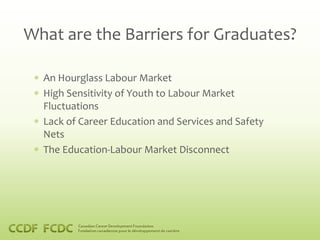Graduates: An At-Risk Group?
- 2. Session Outline What’s the concern for today’s graduates? A look at what the research says Highlight some of the initiatives working to get grads working Look at the recommendations from the Research Examine and consult with you on the need for a School-to-Work Action Group in Canada
- 3. Poorly Integrated New Entrants (PINEs) Who are They? According to OECD (2010): Youth with qualifications (diplomas or degrees) Stuck in temporary work, unemployment or inactivity even in times of economic growth
- 4. PINEs: Why are They a Concern? Global PINE growth in Europe and US Represent 450,000 Canadian Youth Particularly vulnerable during and since the 2008 Recession In Canada, we are not connecting with a vital talent pool in a time of skill shortage Educated but not Employable - This is the labour market paradox for Gen Y!
- 5. How Bad is it in Canada? Not Bad (pre-recession) In “Off to a Good Start,” (2010) the OECD painted a rosy picture for Canadian youth Smooth transitions (75% of youth find permanent and full-time work) Youth move from low-wage to higher wage jobs quickly Long-term unemployment low Canadian youth graduate with significant work experience
- 6. How Bad is it in Canada? Bad (pre and post-recession) Under-employment number 2nd highest in OECD since 2005 More and more youth are in precarious employment (temporary contracts, part-time) Persistently high unemployment (in general and in the summer months) impacting ability to gain workplace skills Glut of university generalists that don’t directly connect with the labour market
- 7. What are the Barriers for Graduates? An Hourglass Labour Market High Sensitivity of Youth to Labour Market Fluctuations Lack of Career Education and Services and Safety Nets The Education-Labour Market Disconnect
- 8. The Hourglass Labour Market • Growth of knowledge worker jobs and entry level jobs • Career progression has fundamentally changed • Glut of PSE graduate raises the credential level of both poles • Youth getting stuck in service sector jobs they work in during school • Need for career management skills to maneuver in this labour market Chart 1: Ontario Job Distribution by Skill Categories, Ontario 1991-2006 (Zizys, 2011, 27)
- 9. Sensitivity to Labour Market Fluctuations Last in and first out phenomenon Disproportionate numbers of youth hit because they are working in sectors hardest hit by recessions (e.g. construction and retail) PINEs may fall through the service cracks
- 10. Lack of Career Education/Service and Safety Nets Lack of consistency Vulnerability to government funding priorities Youth specific service is dwindling (e.g. Ontario) Research confirms the need for high-quality career guidance = 1. highly qualified professionals; 2. timely and accessible local LMI
- 11. The Education-Labour Market Disconnect Too many youth with the same qualification Over-qualification of the entry level PSE institutions that are not making the link to the labour market Employers not investing in the training of youth or their youth hires
- 12. PINEs: What Works? Early Integration Strategies Post-graduation Strategies Demand-side Strategies Strategies for Diverse Groups
- 13. Early Integration Strategies Career service delivery in advance of graduation that includes: Work experience, Career management skills training, Clear information on pathways to the labour market Career planning that helps youth be intentional with their careers Canada’s approach in this area is fragmented
- 14. University of Regina (UR) Guarantee Program (Saskatchewan) Guarantees a free year of The program consists of: tuition to students in the Transitional support services program who do not Regular academic advising secure career related Exam preparation employment within 6- Time management workshops months of graduating. Career development seminars Co-op programs Mock interview exercises Networking events
- 15. The Guidance Act (Denmark) Goals to increase secondary school graduation rate to 95% and have 50% complete a higher credential All ages policy starting in Grade 8 All labour market pathways are identified and supported Services include: eGuidance Specific Youth Guidance Centres focused on all education and work transitions points Wide stakeholder involvement through national dialogue forums Guidance counsellor training requirements Centre of Guidance Research has been established to build an evidence-base Policy backed by appropriate funding resources
- 16. Post-Graduation Strategies Includes: graduate guarantee programs subsidies and supports for entrepreneurs graduate databases graduate access to income support work experiences (internships)
- 17. Work Factory (Sweden) A local community-based program to help secondary school graduates on income support find work or enter further training Participants take part in a 3 month intensive training to build employability skills, increase self-esteem, health and fitness 60% of participants find work and are able to support themselves, 13% enrol in university or college, 6% receive vocational training Program has saved municipality 14 million SEK (approx. 2 million CAD)
- 18. Demand-Side Strategies Includes: Wage subsidies and subsidies to accommodate apprentices Employer partnerships with education Outreach to employers to participate in early and post-graduation programs
- 19. Partnership Brokers (Australia) Inclusion of key stakeholder groups including employers who plan locally to address youth unemployment by providing a series of needed interventions to high school students including: career planning, work experience, pathways to employment, pre-employment training, and building school/teacher capacity
- 20. Diversity Strategies Policies and programs aimed at PINEs need to look at the full PINEs population as well as specifically at diverse groups
- 21. The Aboriginal Youth Work Exchange Program (Ontario) Program to support diversity recruitment issues within the organization Recognition that programs need to include the young person’s community in the process
- 22. Moving Forward… “A good hockey player plays where the puck is. A great hockey player plays where the puck is going to be.” Wayne Gretzky
- 23. Recommendations National School-to-Work Policy Research Service Delivery Reform Focus on Clear and Alternative Pathways to the Labour Market
- 24. Your thoughts… In terms of school-to-work policy/strategy, what’s already working? What are the main issues that need to be addressed?
- 25. Action Group Consultation Read the School-to-Work Action Group purpose statement. In your opinion, would an action group be a good vehicle to address these issues? What needs to happen to create this group and to make it strong?
- 26. Literature Review and Research Report on PINEs is available at: www.ccdf.ca


























